中考动词时态讲解
- 格式:docx
- 大小:19.41 KB
- 文档页数:7
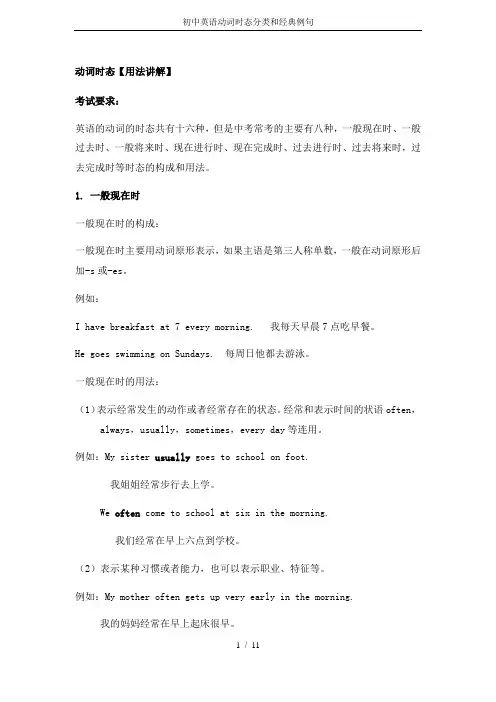
动词时态【用法讲解】考试要求:英语的动词的时态共有十六种,但是中考常考的主要有八种,一般现在时、一般过去时、一般将来时、现在进行时、现在完成时、过去进行时、过去将来时,过去完成时等时态的构成和用法。
1. 一般现在时一般现在时的构成:一般现在时主要用动词原形表示,如果主语是第三人称单数,一般在动词原形后加-s或-es。
例如:I have breakfast at 7 every morning. 我每天早晨7点吃早餐。
He goes swimming on Sundays. 每周日他都去游泳。
一般现在时的用法:(1)表示经常发生的动作或者经常存在的状态。
经常和表示时间的状语often,always,usually,sometimes,every day等连用。
例如:My sister usually goes to school on foot.我姐姐经常步行去上学。
We often come to school at six in the morning.我们经常在早上六点到学校。
(2)表示某种习惯或者能力,也可以表示职业、特征等。
例如:My mother often gets up very early in the morning.我的妈妈经常在早上起床很早。
This kind of car runs very fast.这种小汽车跑得非常快。
(3)表示客观事实、客观规律或者客观真理。
例如:This kind of trees never grows in the desert.这种树从来不在沙漠里生长。
Do you know that knowledge is power?你知道知识就是力量吗?(4)在时间、条件、让步等状语从句中,表示将来的动作。
例如:They’ll be so happy when I tell them.我告诉他们时,他们会很高兴的。
If you aren’t here on time tomorrow, I’ll write to your parents.如果你明天不准时到,我就给你父母亲写信。
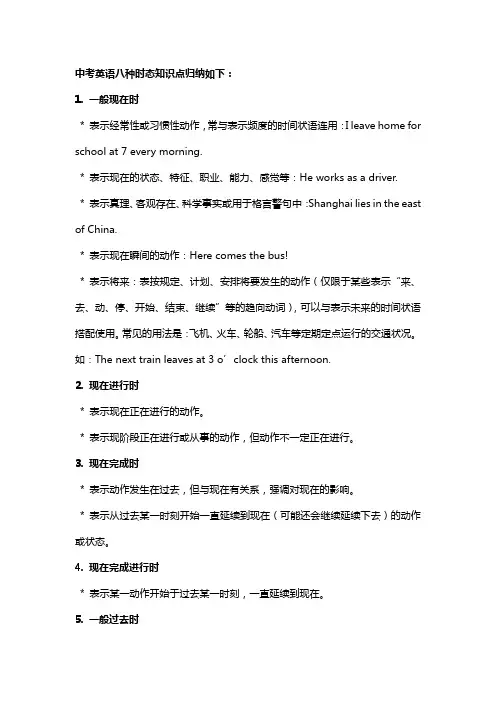
中考英语八种时态知识点归纳如下:1. 一般现在时* 表示经常性或习惯性动作,常与表示频度的时间状语连用:I leave home for school at 7 every morning.* 表示现在的状态、特征、职业、能力、感觉等:He works as a driver.* 表示真理、客观存在、科学事实或用于格言警句中:Shanghai lies in the east of China.* 表示现在瞬间的动作:Here comes the bus!* 表示将来:表按规定、计划、安排将要发生的动作(仅限于某些表示“来、去、动、停、开始、结束、继续”等的趋向动词),可以与表示未来的时间状语搭配使用。
常见的用法是:飞机、火车、轮船、汽车等定期定点运行的交通状况。
如:The next train leaves at 3 o’clock this afternoon.2. 现在进行时* 表示现在正在进行的动作。
* 表示现阶段正在进行或从事的动作,但动作不一定正在进行。
3. 现在完成时* 表示动作发生在过去,但与现在有关系,强调对现在的影响。
* 表示从过去某一时刻开始一直延续到现在(可能还会继续延续下去)的动作或状态。
4. 现在完成进行时* 表示某一动作开始于过去某一时刻,一直延续到现在。
5. 一般过去时* 表示过去某个时间发生的动作或存在的状态。
* 表示过去经常或反复发生的动作。
6. 过去进行时* 表示在过去某一时刻或某一段时间正在进行的动作。
7. 过去完成时* 表示在过去某一时刻之前已经完成或结束的动作或状态。
8. 一般将来时* 表示将来某个时间要发生的动作或存在的状态。
* 表示将来经常或反复发生的动作。
以上就是中考英语中常见的八种时态,希望对你有所帮助。
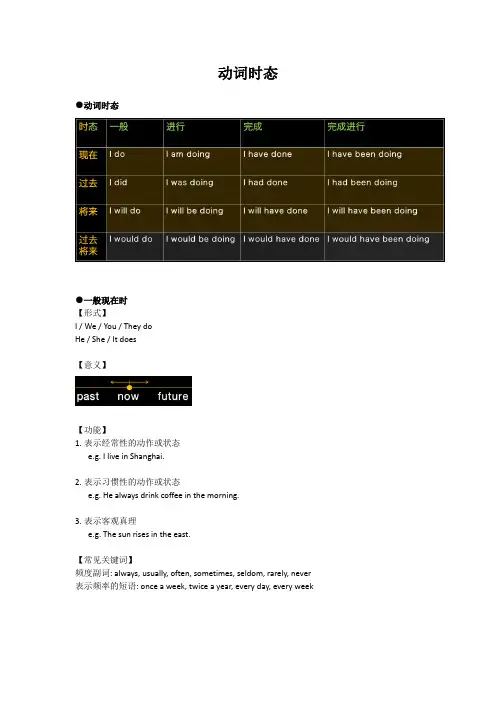
动词时态●动词时态●一般现在时【形式】I / We / You / They doHe / She / It does【意义】【功能】1.表示经常性的动作或状态e.g. I live in Shanghai.2.表示习惯性的动作或状态e.g. He always drink coffee in the morning.3.表示客观真理e.g. The sun rises in the east.【常见关键词】频度副词: always, usually, often, sometimes, seldom, rarely, never 表示频率的短语: once a week, twice a year, every day, every week●现在进行时【形式】I am doingWe / You / They are doingHe / She / It is doing【意义】【功能】1.表示现在正在进行或现阶段正在进行的动作e.g. I'm learning English with Fiona.I am reading this book these days.【常见关键词】now, at present, at the moment, for the time beinglook, listen, be careful【辨析】一般现在时vs现在进行时一般现在时:强调过去现在将来都如此的一贯性现在进行时:强调动作的暂时性(目前如此)I don't really work here. I ______ until the new secretary arrives.A) just help outB) have just helped outC) am just helping outD) will just help out●现在完成时【形式】I / We / You / They have doneHe / She / It has done【意义】【功能】1.动作从过去开始一直持续到现在,现在仍在进行并还有可能延续下去e.g. We have known each other for 7 years since I moved here.2.动作在过去完成,并对现在产生影响,影响一直持续到现在e.g. Where have you put the book? I can't see it anywhere.【常见关键词】Already(用于肯定句中), yet(用于否定句和疑问句中), just, since(自从), for+一段时间, recently, ever, never, by now, so far, in the past few years, in the last ten weeks注意:1)在完成时句中,与for, since, how long连用时,动词要用延续形式。
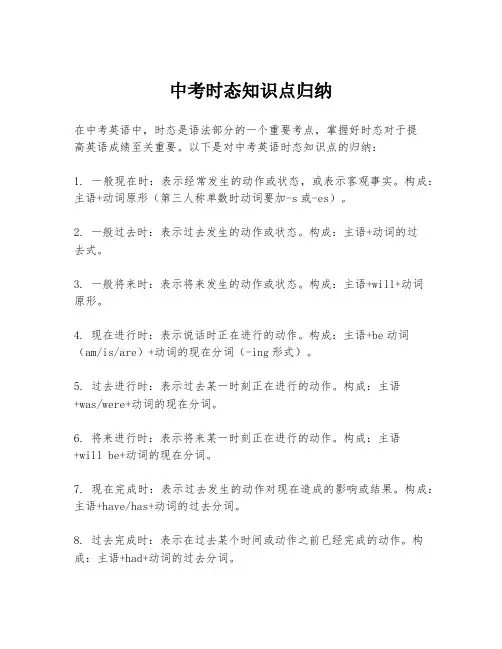
中考时态知识点归纳在中考英语中,时态是语法部分的一个重要考点,掌握好时态对于提高英语成绩至关重要。
以下是对中考英语时态知识点的归纳:1. 一般现在时:表示经常发生的动作或状态,或表示客观事实。
构成:主语+动词原形(第三人称单数时动词要加-s或-es)。
2. 一般过去时:表示过去发生的动作或状态。
构成:主语+动词的过去式。
3. 一般将来时:表示将来发生的动作或状态。
构成:主语+will+动词原形。
4. 现在进行时:表示说话时正在进行的动作。
构成:主语+be动词(am/is/are)+动词的现在分词(-ing形式)。
5. 过去进行时:表示过去某一时刻正在进行的动作。
构成:主语+was/were+动词的现在分词。
6. 将来进行时:表示将来某一时刻正在进行的动作。
构成:主语+will be+动词的现在分词。
7. 现在完成时:表示过去发生的动作对现在造成的影响或结果。
构成:主语+have/has+动词的过去分词。
8. 过去完成时:表示在过去某个时间或动作之前已经完成的动作。
构成:主语+had+动词的过去分词。
9. 将来完成时:表示将来某个时间之前已经完成的动作。
构成:主语+will have+动词的过去分词。
10. 现在完成进行时:表示从过去某一时间开始,一直持续到现在,并且可能还要继续下去的动作。
构成:主语+have/has been+动词的现在分词。
11. 过去完成进行时:表示在过去某一时间之前开始,一直持续到过去某一时间的动作。
构成:主语+had been+动词的现在分词。
12. 被动语态:表示动作的承受者而非执行者。
被动语态的构成根据时态不同而变化,一般形式为:be动词的各种时态形式+动词的过去分词。
掌握这些时态的构成和用法,对于理解和运用英语时态至关重要。
在复习时,可以通过做练习题、阅读例句和进行实际对话来加深理解。
同时,注意时态之间的转换和使用场合,以确保在中考中能够准确无误地使用各种时态。
结束语:通过上述的归纳,希望同学们能够对中考英语中的时态有一个清晰的认识和掌握,为中考取得优异成绩打下坚实的基础。
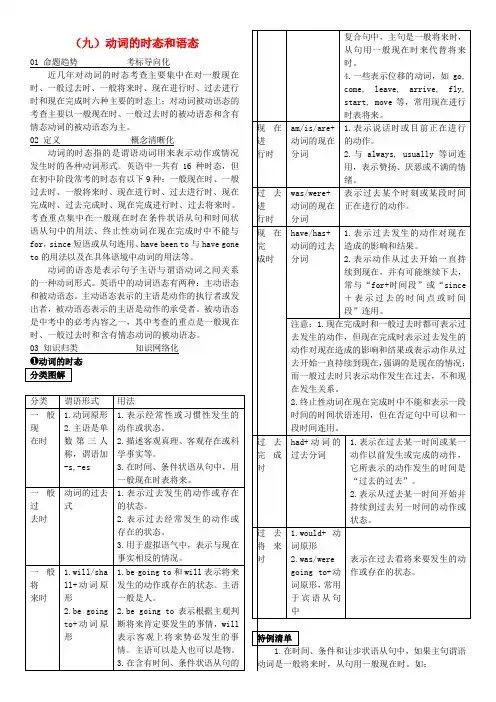
(九)动词的时态和语态01 命题趋势考标导向化近几年对动词的时态考查主要集中在对一般现在时、一般过去时、一般将来时、现在进行时、过去进行时和现在完成时六种主要的时态上;对动词被动语态的考查主要以一般现在时、一般过去时的被动语态和含有情态动词的被动语态为主。
02 定义概念清晰化动词的时态指的是谓语动词用来表示动作或情况发生时的各种动词形式。
英语中一共有16种时态,但在初中阶段常考的时态有以下9种:一般现在时、一般过去时、一般将来时、现在进行时、过去进行时、现在完成时、过去完成时、现在完成进行时、过去将来时。
考查重点集中在一般现在时在条件状语从句和时间状语从句中的用法、终止性动词在现在完成时中不能与for,since短语或从句连用、have been to与have gone to的用法以及在具体语境中动词的用法等。
动词的语态是表示句子主语与谓语动词之间关系的一种动词形式。
英语中的动词语态有两种:主动语态和被动语态。
主动语态表示的主语是动作的执行者或发出者,被动语态表示的主语是动作的承受者。
被动语态是中考中的必考内容之一,其中考查的重点是一般现在时、一般过去时和含有情态动词的被动语态。
03 知识归类知识网络化❶动词的时态1.在时间、条件和让步状语从句中,如果主句谓语动词是一般将来时,从句用一般现在时。
如:We’ll have a picnic if it is fine next Sunday.如果下个星期日天气晴朗,我们将去野餐。
I’ll call you as soon as I get to Beijing tomorrow.我明天一到北京就给你打电话。
2.某些表示起始、往返、出发、到达之意的动词,可用一般现在时表示按规定、计划或安排将要发生的动作(此时一般都有一个表示未来时间的状语)。
这类动词有:begin, come, go, leave, start, arrive, end, stop, open, close等。
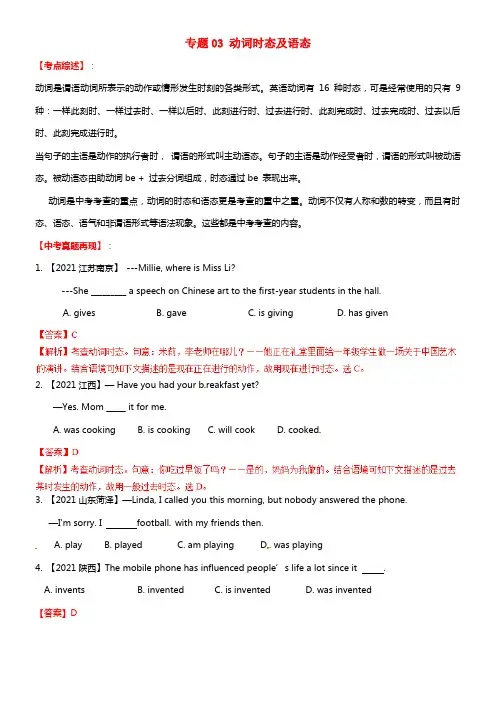
专题03 动词时态及语态【考点综述】:动词是谓语动词所表示的动作或情形发生时刻的各类形式。
英语动词有16种时态,可是经常使用的只有9种:一样此刻时、一样过去时、一样以后时、此刻进行时、过去进行时、此刻完成时、过去完成时、过去以后时、此刻完成进行时。
当句子的主语是动作的执行者时,谓语的形式叫主动语态。
句子的主语是动作经受者时,谓语的形式叫被动语态。
被动语态由助动词be + 过去分词组成,时态通过be 表现出来。
动词是中考考查的重点,动词的时态和语态更是考查的重中之重。
动词不仅有人称和数的转变,而且有时态、语态、语气和非谓语形式等语法现象。
这些都是中考考查的内容。
【中考真题再现】:1. 【2021江苏南京】---Millie, where is Miss Li?---She _________ a speech on Chinese art to the first-year students in the hall.A. givesB. gaveC. is givingD. has given2. 【2021江西】— Have you had your b reakfast yet?—Yes. Mom _____ it for me.A. was cookingB. is cookingC. will cookD. cooked3. 【2021山东菏泽】—Linda, I called you this morning, but nobody answered the phone.—I'm sorry. I football with my friends then.A. playB. playedC. am playingD. was playing4. 【2021陕西】The mobile phone has influenced people’s life a lot since it .A. inventsB. inventedC. is inventedD. was invented【答案】D【解析】考查动词时态及语态。

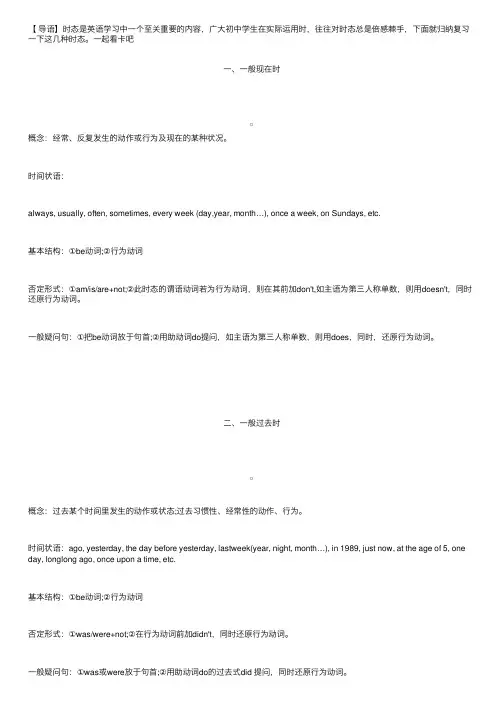
【导语】时态是英语学习中⼀个⾄关重要的内容,⼴⼤初中学⽣在实际运⽤时,往往对时态总是倍感棘⼿,下⾯就归纳复习⼀下这⼏种时态。
⼀起看卡吧⼀、⼀般现在时概念:经常、反复发⽣的动作或⾏为及现在的某种状况。
时间状语:always, usually, often, sometimes, every week (day,year, month…), once a week, on Sundays, etc.基本结构:①be动词;②⾏为动词否定形式:①am/is/are+not;②此时态的谓语动词若为⾏为动词,则在其前加don't,如主语为第三⼈称单数,则⽤doesn't,同时还原⾏为动词。
⼀般疑问句:①把be动词放于句⾸;②⽤助动词do提问,如主语为第三⼈称单数,则⽤does,同时,还原⾏为动词。
⼆、⼀般过去时概念:过去某个时间⾥发⽣的动作或状态;过去习惯性、经常性的动作、⾏为。
时间状语:ago, yesterday, the day before yesterday, lastweek(year, night, month…), in 1989, just now, at the age of 5, one day, longlong ago, once upon a time, etc.基本结构:①be动词;②⾏为动词否定形式:①was/were+not;②在⾏为动词前加didn't,同时还原⾏为动词。
⼀般疑问句:①was或were放于句⾸;②⽤助动词do的过去式did 提问,同时还原⾏为动词。
三、现在进⾏时概念:表⽰现阶段或说话时正在进⾏的动作及⾏为。
时间状语:now, at this time, these days, etc.基本结构:am/is/are+doing否定形式:am/is/are+not+doing.⼀般疑问句:把be动词放于句⾸。
四、过去进⾏时概念:表⽰过去某段时间或某⼀时刻正在发⽣或进⾏的⾏为或动作。
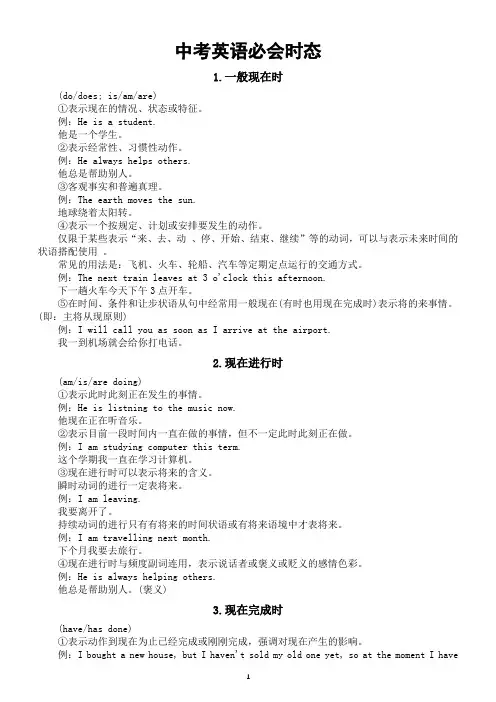
中考英语必会时态1.一般现在时(do/does; is/am/are)①表示现在的情况、状态或特征。
例:He is a student.他是一个学生。
②表示经常性、习惯性动作。
例:He always helps others.他总是帮助别人。
③客观事实和普遍真理。
例:The earth moves the sun.地球绕着太阳转。
④表示一个按规定、计划或安排要发生的动作。
仅限于某些表示“来、去、动、停、开始、结束、继续”等的动词,可以与表示未来时间的状语搭配使用。
常见的用法是:飞机、火车、轮船、汽车等定期定点运行的交通方式。
例:The next train leaves at 3 o'clock this afternoon.下一趟火车今天下午3点开车。
⑤在时间、条件和让步状语从句中经常用一般现在(有时也用现在完成时)表示将的来事情。
(即:主将从现原则)例:I will call you as soon as I arrive at the airport.我一到机场就会给你打电话。
2.现在进行时(am/is/are doing)①表示此时此刻正在发生的事情。
例:He is listning to the music now.他现在正在听音乐。
②表示目前一段时间内一直在做的事情,但不一定此时此刻正在做。
例:I am studying computer this term.这个学期我一直在学习计算机。
③现在进行时可以表示将来的含义。
瞬时动词的进行一定表将来。
例:I am leaving.我要离开了。
持续动词的进行只有有将来的时间状语或有将来语境中才表将来。
例:I am travelling next month.下个月我要去旅行。
④现在进行时与频度副词连用,表示说话者或褒义或贬义的感情色彩。
例:He is always helping others.他总是帮助别人。
(褒义)3.现在完成时(have/has done)①表示动作到现在为止已经完成或刚刚完成,强调对现在产生的影响。
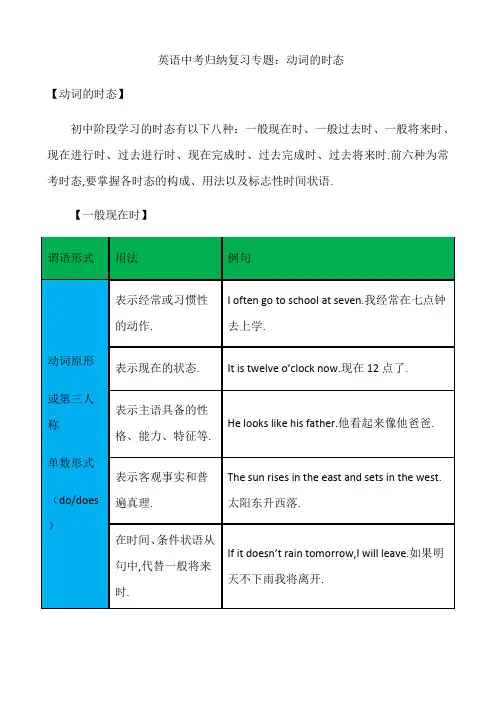
英语中考归纳复习专题:动词的时态【动词的时态】初中阶段学习的时态有以下八种:一般现在时、一般过去时、一般将来时、现在进行时、过去进行时、现在完成时、过去完成时、过去将来时.前六种为常考时态,要掌握各时态的构成、用法以及标志性时间状语.【一般现在时】【考点训练1】1.My father is a teacher and he _________ (teach) in a middle school.2.Yesterday the teacher told us the earth _______ (go) around the sun.3.—When shall we begin our meeting?—We’ll begin it when Helen ___ . ()esB.cameC.will comee4.—How do you usually go to school?—I usually ___ to school on foot. ()A.goB.wentC.was goingD.will go答案:teaches goes A A【一般过去时】要点提醒:“used to+动词原形”表示过去的习惯或状态.如:Mum used to tell us stories.妈妈过去常给我们讲故事.【考点训练2】1.Mike ________ (not go) to bed until 12 o’clock last night.2.He asked if I _____ (be) a student.3.Will you please say it again?I ___ quite ___ you.()A.don’t;hearB.didn’t;hearC.don’t;heardD.didn’t;heard4.He _____ go out with his parents,but now he ____ staying at home alone. ()ed to;is used toB.is used to;used toe to;is used toed to;used to答案:didn’t go was B A【一般将来时】要点提醒:be going to与will的区别1.be going to 指已计划好的事或思考过的意图、打算,will表示未事先思考或未计划而临时做出的决定.如:I’m going to see him tomorrow.我打算明天去看他.(事先经过思考)I’ll answer the door.我去开门.(未经事先考虑)2.be going to可表示客观迹象表明马上要发生的事,而will则表明说话者的主观意愿.如:Look at the clouds.There is going to be a storm.看看这些云,暴风雨就要来了.(客观迹象表明要发生)I hope it will be warm tomorrow.我希望明天会暖和起来.(主观意愿)3.在含有条件状语从句的复合句的主句中,一般用will,不用be going to. 如:I will come if it doesn’t rain.如果不下雨的话,我就来.【考点训练3】1.____ a concert in our school next Saturday. ()A.There isB.There areC.There will beD.There will have2.If they can arrive by 9:00 am,we ___ a meeting.()A.haveB.will haveC.hadD.would have3.He ___ her a beautiful hat on her next birthday.()A.givesB.gaveC.will givingD.is going to give答案:C B D 【现在进行时】【考点训练4】1.They ____________ (have) a math test in the classroom now.2.Look! He ___________ (lie) on the beach.3.—Pass the raincoat to me.It ___ hard now.—Here you are. ()A.rainB.is rainingC.rainedD.will rain4.—Cathy,can you answer the door?I ___ the room.—I’m coming,Mum. ()A.CleanB.cleanedC.have cleanedD.am cleaning答案:are having is lying B D【过去进行时】He was forever com plaining about something.他老是怨这怨那.要点提醒:1.在含有时间状语从句的复合句中,延续时间较长的动作常用过去进行时,另一个短暂性动作用一般过去时.如:When the UFO landed,I was shopping at the clothes store.当UFO落地时,我正在服装店买衣服.2.表示两个延续性动作在过去某一时刻同时进行,不考虑动作的先后顺序,主句和从句的谓语动词都用过去进行时,连词常用while.如:Tom was doing his homework while I was reading a newspaper.我在看报纸时,汤姆在做作业.【考点训练5】1.Mike and I ___________ (play) basketball at that time yesterday afternoon.2.While Mr.Johnson _______________ (work) in the office,the phone rang.3.The girl ___ for the bus when the rainstorm came.()A.waitedB.have waitedC.is waitingD.was waiting4.—Jenny,I called you at nine last night,but you didn’t pick up.—Oh,I ____ a popular program called Go Fighting!.()A.watchB.watchedC.was watchingD.am watching答案:were playing was working D C【现在完成时】要点提醒:1.have/has been to,have/has gone to与have/has been in(考点讲解详见P74考点1)2.延续性动词与非延续性动词英语中的动词按动作发生的方式、发生过程的长短可分为延续性动词和非延续性动词两种,非延续性动词也可称为短暂性动词或瞬间动词.在现在完成时态中,有时要将非延续性动词转换为延续性动词,这样才能和时间段连用.转换方法如下:(1)将短暂性动词转换为“be+形容词或副词”.请看下表:如:这间商店开门6小时了.The shop has opened for 6 hours.( ×)The shop has been open for 6 hours.( √)(2)有的短暂性动词可以转换为意思相同的延续性动词.请看下表:如:这本书我借了一个月了.I have borrowed the book for one month.( ×)I have kept the book for one month.( √)3.现在完成时与一般过去时的区别现在完成时强调某一动作或状态对现在造成的影响或结果,不能和表示过去的时间状语连用;一般过去时只表示过去的事实,不表示和现在的关系,可以和表示过去的时间状语连用.如I bought a ticket yesterday.我昨天买了一张票.(强调我昨天做的一件事是买票)I have already bought a ticket.我已经买了一张票.(强调我已经有票了,无须再惦记票的事了)4.现在完成时的其他句型【考点训练6】1.—you _____ your homework yet?—Yes.I ______ it a moment ago. ()A.Did;do;finishedB.Have;done;finishedC.Have;done;have finishedD.Will;do;finish2.His father ___ the Party since 1978. ()A.joinedB.has joinedC.was inD.has been in3.Miss Green isn’t in the office.She to the library. ()A.has goneB.wentC.will goD.has been 答案:B D A【过去完成时】had + 过去分词表示在过去的过去发生的动作或存在的状态.I had had three pieces of cake when you arrived.你来的时候我已经吃了三块蛋糕了.表示过去某一动作或状态持续到过去另一时间.The old man had lived in Shanghai for ten years beforeTom came here.汤姆来这儿之前,这个老人已经住在上海十年了.时间标志by the time...,before,when等构成的短语或引导的从句【考点训练7】1.在我们到达电影院之前,电影已经开始了.The film __________ before we _______ to the cinema.2.警察赶到时,小偷已经逃跑了.When the police __________,the thief____________________ .答案:had begun got arrived had run away 【过去将来时】【考点训练8】1.李明说如果布莱恩下个月来中国,他将会很高兴.Li Ming said he ___________ happy if Brian came to China the next month.2.蒂娜说她下周三打算来参加我的生日派对.Tina said she ________________ my birthday party the next Wednesday.答案:would be was going to【中考示例】(2017·广西)If he _____ Guilin,he’ll probably go to Yangshuo. ( )A.visitsB.is visitingC.will visitD.has visited【解析】考查动词的时态.句意:如果他游览桂林,他有可能会去阳朔.if引导条件状语从句时,时态遵循“主将从现”原则,从句中用一般现在时表示将来.【考题热身】1.(2017·甘肃)I promise I ________ (send) you an email to explain all of these tomorrow.2.(2017·甘肃)Be quiet! The patients ______________(sleep).3.(2017·鄂州)Sandy’s grandparents__________________ (marry) for 50 years.4.(2017·台州改编)A true friend always ____________(support) you whenever youare in trouble.5.(2017·宿迁)I ______________(wash) the dishes while my sister was sweeping the floor.6.(2017·云南)—What do you think of your hometown, Kate?—It a lot.It’s more beautiful than before. ()A.has changedB.changesC.will changeD.change7.(2017·武汉)—Linda is not coming for the party tonight.—But she ______!()A.promisesB.promisedC.will promiseD.had promised8.(2017·毕节)It’s nice to see you again.We ___ each other since 2016. ()A.won’t seeB.haven’t seenC.don’t seeD.didn’t see9.(2017·黔东南)If it doesn’t rain this weekend,we ___ a picnic in the Jinquan Park. ()A.haveB.will haveC.have hadD.had10.(2017·上海)Some exchange students ___ with their host families this time yesterday. ()A.are chattingB.will chatC.were chattingD.have chatted11.(2017·重庆B卷)—Where is your uncle?I haven’t seen him for a long time. —He _____ Beijing for about half a year.He moved there in January. ()A.has gone to B.has been toC.has arrived inD.has been in12.(2017·重庆B卷)John and I ___ to visit his grandparents last Sunday afternoon. ()A.goB.wentC.will goD.have gone13.(2017·重庆A卷)In the past few years,many schools ____ the ways of doing morning exercises. ()A.changeB.changesC.will changeD.have changed14.(2017·重庆A卷)As soon as the rain _____ ,they will go out to pick apples. ()A.stopsB.stoppedC.will stopD.is stopping15.(2017·河北)Don’t take the dictionary away.I ___ it. ()eedC.am usingD.have used答案:will send are sleeping have been married supports A B BBCDBDAC。

英语中考时态的区分1.一般现在时VS 现在进行时一般现在时态表示目前经常发生或者习惯性的动作,表示客观事实、主语目前的特征、姿态和能力等。
现在进行时则表示说话时正在进行的动作,或者阶段正在进行而说话时不一定在进行的动作。
①一般现在时态表示“存在状况”时,常用于表示状态的动词,如be keep remainstay have等,而这些动词一般很少用于现在进行时。
例. Manda has a strong accent of an American. 曼达带有浓重的美国口音。
②以here there 开头的句子说明正在发生的动作,谓语不用进行时,而用一般现在时。
例. Listen! There goes the first bell. 听,预备铃响了!③表示动作的动词,必须是习惯的、经常的动作或是一般性的行为才使用一般现在时,而这种动词在现在进行时中往往表示现在或目前一小段时间内正在进行的动作。
例. She is visiting Canada. 她正在采访加拿大!④有些动词,如taste smell sound look等,在一般现在时中是连系动词,而在进行时中则为行为动词。
例. I am looking at the picture by XX, It looks really nice.2.一般过去时 VS 现在完成时①一般过去时所表示的一个或一段过去时间是可以具体确定的,与其他时间没有牵连;它所表示的事情纯属过去,与现在情况没有关系。
现在完成时所表示的事情发生在不能具体指出的过去某个或某段时间;它所表示的事情与现在情况有关系,是过去发生的事情在现在产生的结果或对现在的影响,或一直持续着。
Did you go to Canada last year? 你去年去加拿大了吗(表示去年发生的行为Have you ever been to Canada? 你去过加拿大吗?(表示过去某个时间发生的行为,但问现在的情况,即你对那里了解多少。
中考英语必考时态结构及用法详解一、一般现在时【标志】动词原形1.表示经常性或习惯性动作,常与表频度的时间状语连用:She often speaks English.I leave home for school at 7 every morning.2.表示现在的状态、特征、职业、能力、感觉等:He seems to feel a bit down today.He works as a driver.3.表示真理、客观存在、科学事实或用于格言警句中:Shanghai lies in the east of China.Columbus proved that the earth is round.Where there is a will, there is a way.4.表示现在瞬间的动作:Here comes the bus!5.表示将来1) 表按规定、计划、安排将要发生的动作(仅限于某些表示“来、去、动、停、开始、结束、继续”等的趋向动词),可以与表示未来的时间状语搭配使用。
常见的用法是:飞机、火车、轮船、汽车等定期定点运行的交通状况。
如:The next trai n leaves at 3 o’clock this afternoon.How often does the shuttle bus run?2) 在时间和条件状语从句中常使用一般现在时表示将来发生的事情:When Bill comes (不用will come), ask him to wait for me.I shall go there tomorrow unless I’m too busy.二、一般过去时【标志】动词过去式1.表示过去某时所发生的动作或存在的状态,常与表示过去的时间状语连用(e.g.yesterday, this morning, just now, a moment ago, in May, last night / year / week, once upon a time, the other day, before …, when …, in the past等)。
(完整版)中考时态专题一般过去时详细讲解及练习一、定义:二、谓语动词结构:1)Be动词:主语+Be的过去式(was /were)+其它。
三、句式一般过去时的肯定式、否定式、疑问式及简略回答。
1) Be动词:①肯定句:主语+was/were+其它。
例如:I was late yesterday.昨天我迟到了。
We were primary students 5 years ago.②否定句:主语+was /were+not+其它。
例如:___(我们昨天没迟到)③一般疑问句:be动词提前。
Was/Were+主语+其它?例如:I was ___(改一般疑问句) →Were you ill yesterday?(你昨天病了吗?)肯定回答:Yes, I was. (是的,我病了。
)否定回答:No, I wasn't. (不,我没病。
)④特殊疑问句:对谓语动词进行提问的:疑问词+was/were+主语+其它(一般疑问句)?2) 实义动词:①肯定句:主语+V-ed+其它。
例如:I called up my good friend just now.②否定句:主语+didn’t+V原形+其它。
例如:I didn’t argue with Tom last week.③一般疑问句:Did+主语+V原形+其它?例如:___ 2010. (改一般疑问句) →Did you buy a souvenir in 2010?肯定回答:Yes, I did.否定回答:No, I didn’t.④特殊疑问句:疑问词+did+主语+V原形+其它?例如:When did you buy the book?(你是什么时候买的这本书?)Finally, let's fill in the blanks with the correct form of the verb. "Was" should be used for the first blank, "played" for the second, "went" for the third, and "read" for the fourth.5. Tom was upset because he had failed the English test again.6. We moved to Beijing 8 years ago.1. C2. C3. B4. A5. C6. A7. B8. ATom was ___ down because he had failed his English test once again. It had e a recurring problem for him. Eight years ago,my family and I relocated to Beijing. This morning, I asked my friend what time she had arrived at school.1. What did they have for breakfast last week?2. ___?3. Jim ___ she was ___.4. They were not late the day before yesterday.5. Where did you go?6. Did Wei Fang have a good time last summer n? Yes, she did. / No, she didn't.7. Li Hong did not do her ___.8. How did Mr Gao go to work last year?9. Is there tea in the cup?1. Did Wei Fang have a good time last summer n? Yes, she did. / No, she didn't.2. Li Hong did not do her ___.3. How did Mr Gao go to work last year?4. Is there tea in the cup?。
初中英语语法:动词时态讲解及练习初中英语语法:动词时态讲解及练动词时态专讲一、概说动词的时态历来是中考题中考查的重头戏之一。
测试重点放在根据特定语言环境区别使用一般现在时,一般过去时和现在完成时;一般现在时(过去时)与现在(过去)进行时;特定的时间状语中时态的使用;结合所获得的语言知识确定正确时态的能力等。
综上所述,动词的时态在中考测试中的地位非常重要。
因而考生在复备考中必须对本专题引起足够的重视。
构成时态二、各种时态的构成do / does一般现在时时态构成did一般过去时am / is / arewas / were现在完成时现在进行时一般将来时am / is / are + doinghave / has + doneshall / will + do曩昔完成时过去进行时过去将来时was / were + doingwould + dohad + donewas / were going + to doam / is / are going + to do普通目前时三、各种时态的用法1.透露表现经常性或气性的举措,常与透露表现频度的工夫状语连用。
时间状语:every day,every other day,sometimes,often,usually,on Sunday …I leave home for school at 7 _________________ (天天清晨).The Olympic Games are held ____________________ (每四年).What do you ____________ (平日) do when you are free on Sunday?2.用在客观真理,客观存在,科学事实或格言警句中。
The earth _________________ (绕着……转) the sun.Shanghai lies in the east of China.上海__________中国的东方。
中考需要掌握的8种时态中考需要掌握的8种时态如下:1.一般现在时:表示经常、反复发生的动作或行为及现在的某种状况。
基本结构是is/am/are或do/does。
否定形式是am/is/are+not或don't+行为动词。
一般疑问句是把is/am/are动词放于句首或助动词do提问,同时还原行为动词。
2.现在进行时:表示现在正在进行的动作或存在的状态。
基本结构是be动词+动词的现在分词。
否定形式是be动词+not+动词的现在分词。
一般疑问句是把be动词放于句首。
3.过去进行时:表示过去某时正在进行的动作或存在的状态。
基本结构是was/were+动词的现在分词。
否定形式是was/were+not+动词的现在分词。
一般疑问句是把was/were放于句首。
4.一般将来时:表示将来某一时间将要发生的动作或情况。
基本结构是will+动词原形,或am/is/are+going to+动词原形。
否定形式是will+not+动词原形,或am/is/are+not+going to+动词原形。
一般疑问句是把will提前提问,或把am/is/are 提前提问。
5.过去将来时:表示过去某一时间将要发生的动作或情况。
基本结构是would+动词原形,或was/were+going to+动词原形。
否定形式是would+not+动词原形,或was/were+not+going to+动词原形。
一般疑问句是把would提前提问,或把was/were提前提问。
6.现在完成时:表示过去发生的动作持续到现在,并可能继续下去。
基本结构是have/has+过去分词。
否定形式是have/has+not+过去分词。
一般疑问句是把have/has提前提问。
7.过去完成时:表示过去的过去某一时间之前已经完成的动作或情况。
基本结构是had+过去分词。
否定形式是had+not+过去分词。
一般疑问句是把had提前提问。
8.一般过去时:表示在过去某个时间发生的动作或情况。
动词时态一.一般现在时(一)用法1 表示经常性、或习惯性的动作。
He often gets up at five o’clock in the morning.2 表示现在或目前的状态。
He is fifteen years old.3 表示主语所具备的性格和能力等。
I like oranges. I can speak English.4 表示按照时间表、节目单,课程表等发生的动作。
如车船飞机等运行的时间等。
The flight to America takes off at 8:00in the morning.5 客观真理、事实、格言、谚语警句等都是使用。
Water boils at 100 ℃。
6 在条件状语从句中和时间状语从句中使用一般现在时代替将来时。
If you work hard ,you will succeed. I will call you as soon as I get home.7 宾语从句中是客观真理时,用一般现在时。
The teacher said the earth goes round the sun. (二)判定的时间标志always,usually,often,sometimes,hardly,ever,never,seldom,every day,on sundays,at weekends,at times,from time to time ,now and then.(三)基本结构:肯定句①主语+be(am/is/are)动词+其他;②主语+行为动词+宾语+其他否定形式:①主语+am/is/are+not+其他;②主语+don’t+行为动词+宾语+其他主语(单数第三人陈)+doesn’t+行为动词+宾语+其他一般疑问句①把be(am/is/are)动词放于句首;②Do+主语+行为动词+宾语+其他?Does+ 主语(单数第三人陈+行为动词+宾语+其他?二一般过去时(一)用法1 表示过去某个时间或某段时间内发生的动作或存在的状态。
He got up at 6:30 yeterday.2 表示过去经常或反复发生的动作或存在的状态。
常与often或always等频度副词连用。
Last year he often wet to work by bus.(二)判定时间标志:①yesterday,yesterday morning( afternoon,evening...),last night(week,year,month...),this morning,one day,at that time ,then,a moment ago,five years ago,(.....ago),just now,at the age of......,once upon a time,the other day,in the past,in+过去的年份。
after+一段时间②when/while ,before引导的表示过去的时间状语从句。
(三)基本结构1 含be 动词的结构肯定句式:主语+ be(was , were) + 其它.否定句式:主语+ be(was , were) + not + 其它.一般疑问句:Be(was , were) + 主语+ 其它?2 含行为动词的句型肯定句式:主语+ 动词(过去式)+ 其它否定句式:主语+ didn’t + 动词(原形)+ 其它 .一般疑问句:Did + 主语+ 动词(原形)+ 其它?规则动词的过去式变化方法1.一般情况下,在动词原形后面加-ed。
look→looked play→played start→started visit→visited pull-pulled, cook-cooked2.以不发音e结尾的动词,在词尾直接加-d。
live→lived use→used taste-tasted3.以“辅音字母+ y”结尾的动词,先将y 改为i ,再加–ed。
study→studied try→tried fly→flied4.以重读闭音节(即辅音+元音+辅音)或r音节结尾,末尾只有一个辅音字母的动词,要先双写这个辅音字母后,再加–ed。
stop→stopped plan→planned stop-stopped prefer→preferred不规则动词的过去式需特殊记忆。
如:am(is)-was, are-were(是), become _became (成为) go-went(走)三一般将来时(一)用法1 表示将来某个时间要发生的动作或存在的状态,或表示将来反复发生的动作。
He will go shopping with his mother tomorrow .2 be going to +动词原形,表示按计划、安排要发生的事情。
He is going to buy some books3 be about to+动词原形,表示很短时间的将来,意为“正要,正准备…”I ‘m about to go upstairs when Jim comes.4 疑问句中,主语为第一人称时,使用shall,含有征求意见的意思,Shall we go to the park ? 在肯定句中,第一人称与will连用,含有意愿色彩,I will tell you about it,我愿告诉这件事.(二)判定的时间标志tomorrow,next week(month.....),this afternoon,this evening,tonight,soon,some day,before long,in +一段时间。
注意There is going to be +主语+.......或There will be+主语+......将有......(三)句型结构(1)肯定句:主语+ will/shall+V原形+其它.I will/shall be a teacher in 10 years.( will be a /an +职业名词)There will be a meeting tomorrow.You will be taller soon.(will be + 形容词) People will have robots in the future.(2)否定句:主语+ will/shall+not+V原形+其它.They will study at home on computers. →They won’t study at home on computers.(3)一般问句:Will/Shall+主语+ V原形+其它?Mary will be in college in 5 years. →Will Mary be in college in 5 years?肯定回答:Yes, she will. 否定回答:No, she won’t.四现在进行时(一)用法1 表示说话瞬间正在进行的或发生的动作。
He is watching TV now.2 表示当前一段时间或现阶段正在进行的动作We are working on a farm these days.3 某些表示位置转移的动词用进行时表示将来,come ,go,arrive,leave,start,begin,fly,drive,die We are leaving for Shanghai tomorrow.4 现在进行时与always连用,表示说话人的赞赏和厌烦等,带有一定的感情色彩。
They are always talking about it.5 心里动词不能用于进行时态中。
(二)判定的时间标志now,at the moment,at present,these days,right now,或句前有look,listen,Be quiet(三)句型结构肯定句式:主语+be( am, is, are)+现在分词+其它.否定句式:主语+be(am, is, are) +not +现在分词+其它.一般疑问句:Be(am, is, are) +主语+现在分词+其它?特殊疑问句:疑问词+be(am, is, are)+主语+现在分词+其它?动词现在分词的变化规则1. 一般情况下,直接在动词后加-ing,如: work - working study - studying2. 动词以不发音的-e结尾,要去-e加-ing,如: make - making dance - dancing3. 重读闭音节的动词,要双写词尾字母,再加-ing,如: put - putting begin - beginning4. 以-ie结尾的动词,把-ie变成y再加-ing,如: lie - lying tie - tying五过去进行时(一)用法表示过去某一时刻或某一段时间正在进行的动作What were you doing at eight last night?(二)判定时间标志① just then,at this time ,at that time,at+ 钟点+last night, (at)this time yesterday ,from seven to nine yesterday/the day before yesterday,② when /while 引导的时间状语从句③根据上下文来判断。
(三)句型结构1. 肯定句: 主语+was/were+V-ing+其它 .I was watching TV at that time last night.2. 否定句: 主语+was/were+not+V-ing+其它 .→I was not watching TV at that time last night.3一般疑问句:was/were+主语+V-ing+其它?→Were you watching TV at that time last night?肯定回答:Yes, I was. 否定回答:No, I wasn’t.4. 特殊问句: 疑问词+was/were+主语+V-ing+其它?→What were you doing at at that time last night?六现在完成时(一)用法1 表示过去发生或已完成的动作对现在造成的影响或结果。
Have you had your lunch yet ?2 表示从过去某一时间开始一直持续到现在的(包括现在在内)的动作或状态,并有可能持续下去。
动词要用延续性动词,并且与一段时间连用。
I have lived here for ten years.3 表示说话前发生过一次或多次的动作,成为一种经验或经历,与twice ,three times,ever ,never,等连用。